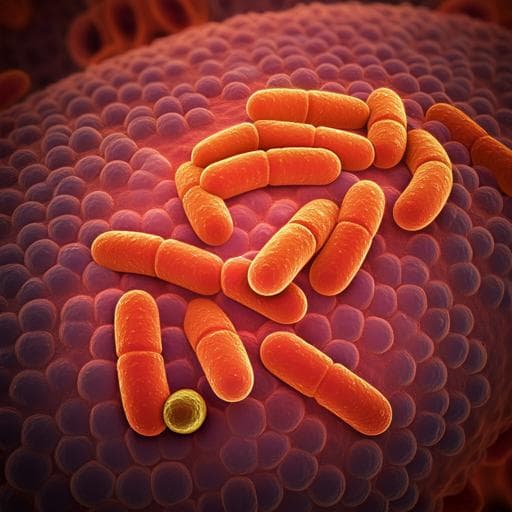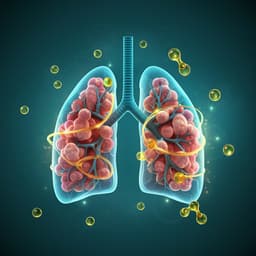
Medicine and Health
Protection against DSS-induced colitis in mice through FcεRla deficiency: the role of altered *Lactobacillus*
Y. Yin, R. Wang, et al.
This intriguing study explores the controversial role of mast cells in ulcerative colitis, revealing that FcεRI can serve as a diagnostic marker. Research conducted by Yue Yin, Ruilong Wang, Yanning Li, Wenfei Qin, Letian Pan, Chenyuan Yan, Yusen Hu, Guangqiang Wang, Lianzhong Ai, Qixiang Mei, and Li Li highlights the impact of gut microbiota, particularly *Lactobacillus*, in modulating colitis severity.
~3 min • Beginner • English
Introduction
Inflammatory bowel diseases, including ulcerative colitis (UC), are increasing globally and impose substantial health and economic burdens. Mast cells (MCs) and their high‑affinity IgE receptor FcεRI are central to allergic activation, but their roles in UC pathogenesis remain unclear despite reports of elevated IgE in UC. Dysbiosis of the gut microbiota is a recognized contributor to UC, and microbial products can interact with receptors on MCs, suggesting a potential link between allergic signaling, MC activation, and intestinal microbes. This study investigates whether FcεRIα (the IgE‑binding α‑chain) influences DSS‑induced colitis, tests anti‑FcεRI autoantibodies as a diagnostic biomarker for UC, and explores how FcεRIα deficiency modulates gut microbiota—particularly Lactobacillus—and downstream inflammasome signaling to affect intestinal inflammation and barrier integrity.
Literature Review
Prior work implicates mast cells and basophils in intestinal inflammation and UC, though mechanisms are debated. FcεRI mediates IgE‑dependent activation and can be engaged by anti‑FcεRI autoantibodies in autoimmune settings. UC has been associated with altered gut microbiota composition and metabolic activity, and MC–microbiota interactions can modulate disease, with microbial metabolites influencing host immunity. NOD‑like receptors, including NLRP6, regulate inflammasomes, mucin secretion, and antimicrobial peptides and have been linked to colitis outcomes. Lactobacillus spp. have probiotic properties, enhancing mucus thickness, modulating immunity, and ameliorating experimental colitis in prior studies, potentially via lactic acid production. However, a clear mechanistic connection among FcεRI signaling, specific microbial taxa, and inflammasome pathways in UC has been lacking.
Methodology
Clinical cohorts: From 2020–2021, 62 UC patients (48 Shanghai General Hospital, 14 Shanghai Renji Hospital) and 75 healthy controls (HCs) were recruited (age/sex balanced). Serum IgE, anti‑IgE (aIgE), and anti‑FcεRI (aFcεRI) were measured; ROC analyses yielded training (n=48 UC) and validation (n=16 UC) performance, compared against ANCA and GAB. Colonic tissues were analyzed for mast cells (tryptase), FcεRI protein (IF) and FcεRIα mRNA (qPCR). Animal models: Female BALB/c mice (6–8 weeks). FceRIα knockout (FC) mice generated; DSS colitis induced by 3% DSS in drinking water for 7 days; euthanasia day 10. Groups: WT control (CON), FC control (FC), WT+DSS (DSS), FC+DSS (FCDSS) (n≥6–8/group). Outcomes: body weight, DAI (stool, bleeding), colon length, histology (H&E), Claudin‑1 IF, goblet cells by PAS (MUC2 IF), histopathological scoring. Cytokines (IL‑1β, IL‑6, TNF‑α, IL‑10) measured by ELISA. Immune profiling: Flow cytometry of MLN and spleen for Th17 (CD4+IL‑17A+) and Treg (CD4+CD25+Foxp3+) frequencies. Microbiome: Fecal 16S rRNA gene sequencing (QIIME2/DADA2; SILVA v138); alpha diversity (Shannon), beta diversity (Bray‑Curtis PCoA, PERMANOVA), LEfSe (LDA>3.5, P<0.05), Wilcoxon tests (genus level), relative abundance analyses; correlations (Spearman) between taxa and histology, cytokines, goblet cells. Fecal Microbiota Transplantation (FMT): Antibiotic‑treated WT recipients received fecal transplants from WT (FMT1) or FC (FMT2) donors, followed by DSS; outcomes as above. Cohousing: WT and FC mice cohoused 30 days vs housed separately, then DSS; compared clinical, barrier, immune, and microbiome readouts. Mast cell–Lactobacillus interaction: Activated mast cell (RBL‑2H3) supernatants tested for bacteriostatic activity against Lactobacillus plantarum AR113 (Oxford cup assay; OD600 after co‑culture with serially diluted supernatant). FcεRI surface expression on RBL‑2H3 assessed by flow cytometry with/without lactic acid pretreatment. Transcriptomics: Intestinal RNA‑seq (Illumina HiSeq/NovaSeq), differential expression and KEGG pathway enrichment; validation by qPCR of NLRP6 inflammasome components (NLRP6, ASC, Caspase‑1, IL‑18), MUC2, AMPs (Ang4, ITLN1, RELMB). Organoid and in vivo Lactobacillus interventions: Mouse colonoids pretreated with L. plantarum AR113 then TNF‑α; gene expression of NLRP6 pathway, MUC2, and AMPs measured. In vivo supplementation: WT mice gavaged 7 days with L. plantarum AR113 or an LDH‑deficient AR113Δ177840467 (lactate‑deficient) prior to DSS; lactate levels by GC‑MS; outcomes included colon length, body weight, DAI, cytokines, histology, Claudin‑1, goblet cells. Statistics: Student’s t‑test or Kruskal–Wallis as appropriate; P<0.05 significant.
Key Findings
- Diagnostic biomarker: UC patients had elevated serum IgE and markedly higher anti‑FcεRI (aFcεRI) versus HCs; aIgE was not different. Training cohort AUCs: aFcεRI 0.848 (95% CI 0.778–0.919), IgE 0.614, aIgE 0.591, GAB 0.583, ANCA 0.820; aFcεRI+ANCA AUC 0.956 (0.921–0.990). Validation cohort AUCs: aFcεRI 0.775 (0.606–0.944), IgE 0.603, aIgE 0.584, ANCA 0.880, GAB 0.679; aFcεRI+ANCA 0.923 (0.802–1.000). UC colonic tissue showed increased tryptase+ MCs, FcεRI protein, and FcεRIα mRNA.
- Disease attenuation in FcεRIα KO: Compared to DSS‑WT, DSS‑FC mice had longer colons, less weight loss, lower DAI, improved histology, higher Claudin‑1, preserved crypts, and more goblet cells (MUC2+). Serum IL‑1β, IL‑6, TNF‑α decreased and IL‑10 increased in DSS‑FC vs DSS‑WT. Th17 frequencies decreased and Treg increased in MLN/spleen of DSS‑FC vs DSS‑WT.
- Microbiome modulation: DSS reduced alpha diversity; FcεRIα deficiency restored diversity and shifted community structure (PCoA; PERMANOVA significant). Genus‑level changes included higher Lactobacillus in FC mice with or without DSS; DSS‑induced Alistipes expansion was attenuated in FC mice; norank_f_Lachnospiraceae increased in FCDSS vs DSS. Spearman correlations showed Lactobacillus abundance strongly negatively correlated with histological score and pro‑inflammatory cytokines (IL‑1β, IL‑6, TNF‑α) and positively correlated with goblet cell numbers and IL‑10; other taxa (Alistipes, norank_f_Lachnospiraceae, Lachnospiraceae_NK4A136) did not show strong correlations.
- Causality via microbiota transfer and cohousing: FMT from FC donors (FMT2) into antibiotic‑treated WT recipients conferred protection—reduced DAI, cytokines, improved histology, Claudin‑1, and goblet cells—relative to FMT from WT (FMT1). Thirty‑day cohousing equalized phenotypes and microbiota between WT and FC under DSS, abolishing differences in cytokines and T cell subsets.
- MC–Lactobacillus interaction: Supernatants from activated mast cells inhibited L. plantarum growth in vitro in a concentration‑dependent manner, suggesting MC activation can suppress Lactobacillus abundance.
- Inflammasome pathway: RNA‑seq in DSS colitis identified 295 DEGs between WT and FC; KEGG enrichment highlighted NOD‑like receptor signaling with increased NLRP6 inflammasome components (NLRP6, ASC, Caspase‑1, IL‑18), along with higher MUC2 and AMPs (Ang4, ITLN1, RELMB) in FC mice.
- Role of Lactobacillus and lactate: L. plantarum AR113 activated NLRP6 pathway genes and increased MUC2/AMPs in TNF‑α–injured colonoids and DSS‑treated mice; fecal microbiota from FC mice similarly induced these genes. In vivo, AR113 supplementation mitigated DSS colitis (improved colon length, body weight, DAI; lower IL‑1β/IL‑6/TNF‑α; better histology, Claudin‑1, and goblet cells). An LDH‑deficient AR113Δ177840467 strain that cannot produce lactate failed to confer protection and was associated with worse inflammatory readouts versus AR113, implicating lactate as a key effector. Lactic acid did not alter FcεRI surface expression on mast cells, indicating FcεRI knockout is upstream of microbiota‑metabolite effects.
Discussion
The study demonstrates that FcεRIα signaling promotes susceptibility to DSS‑induced colitis and that its genetic ablation confers protection through reshaping the gut microbiota, prominently increasing Lactobacillus. The protective phenotype is transmissible via FMT and is diminished by cohousing, supporting a microbiota‑dependent mechanism. Mechanistically, FcεRIα deficiency is linked to activation of the NLRP6 inflammasome pathway, with increased IL‑18, mucin (MUC2), and antimicrobial peptides that preserve barrier integrity and goblet cells. Lactobacillus treatment reproduces these molecular signatures in organoids and mice, while loss of bacterial lactate production abrogates benefit, pointing to lactate as a critical metabolite mediating NLRP6 activation and mucosal protection. The findings integrate allergic receptor signaling, microbiome composition, and inflammasome‑driven barrier defense, addressing the research question by identifying FcεRIα–microbiota–NLRP6 as an axis modulating colitis severity and by proposing anti‑FcεRI autoantibodies as a clinically relevant biomarker for UC.
Conclusion
Anti‑FcεRI autoantibodies exhibit strong diagnostic performance for UC. Genetic deficiency of FcεRIα attenuates DSS‑induced colitis by reducing inflammation, restoring Th17/Treg balance, and preserving epithelial barrier and goblet cells in a microbiota‑dependent manner. FcεRIα knockout enriches Lactobacillus, whose lactic acid production activates NLRP6 inflammasome signaling to promote MUC2 and AMP secretion and protect the mucosa. Supplementation with Lactobacillus plantarum confers protection, whereas a lactate‑deficient mutant does not, implicating lactate as a key mediator. Future work should validate aFcεRI as a biomarker in larger, diverse UC cohorts; dissect molecular links between lactate and NLRP6 signaling; evaluate probiotic or metabolite‑based interventions clinically; and explore additional mast cell–microbiota pathways in chronic and humanized models.
Limitations
- In vitro bacteriostatic assays of mast cell supernatants against Lactobacillus may not fully reflect in vivo complexity, as acknowledged by the authors.
- Mouse studies used a single acute DSS colitis model in female BALB/c mice, which may limit generalizability to other strains, sexes, chronic models, or human disease.
- Clinical biomarker analyses involved modest cohort sizes from two centers and require external validation and standardization.
- Microbiome analyses are correlative beyond FMT/cohousing; while Lactobacillus correlated strongly with protection, other taxa and metabolites may contribute.
- The probiotic intervention tested a single L. plantarum strain and one engineered lactate‑deficient mutant; broader strain diversity and dose–response relationships were not explored.
Related Publications
Explore these studies to deepen your understanding of the subject.







